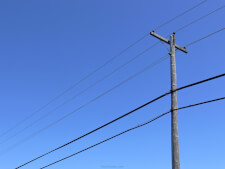POTS
Stands for "Plain Old Telephone Service." POTS is the traditional telephone system that has been around for nearly 150 years. It operates over copper wires and was designed for analog signal transmission.
For most of the past century, POTS has been the primary telecommunications medium. The infrastructure, such as telephone poles and telephone wires, can be found throughout the United States and around the world. Over the past few decades, digital alternatives, such as VoIP and cellular service, have largely replaced traditional phone plans. Many telephone poles now carry digital fiber optic cables alongside the copper wires. Some include public Wi-Fi repeaters and cellular transmitters.
While POTS is gradually becoming obsolete, there are a few advantages to the traditional phone system:
- High reliability (roughly 99.999%)
- No external electrical power required (copper wires carry low voltage)
- Large existing global infrastructure
- Ability to handle analog and digital signals
- Clear, uncompressed voice audio
Some disadvantages of POTS vs modern telecommunications systems include:
- No wireless option (besides in-home handsets)
- Expensive, especially for international calls
- Limited bandwidth for transmitting digital signals (and therefore low speeds)
- Requires significant above-ground infrastructure
- Audio frequency range is limited between 300 and 3,300 Hz
POTS vs Landlines
The terms "POTS" and "landline" are sometimes used interchangeably. Often, they mean the same thing. However, POTS refers to a phone system that operates over analog telephone wires. A landline may either use POTS or a digital voice service like Vonage or Comcast Digital Voice. Therefore, POTS requires a landline, but a landline may or may not use POTS.
 Test Your Knowledge
Test Your Knowledge
